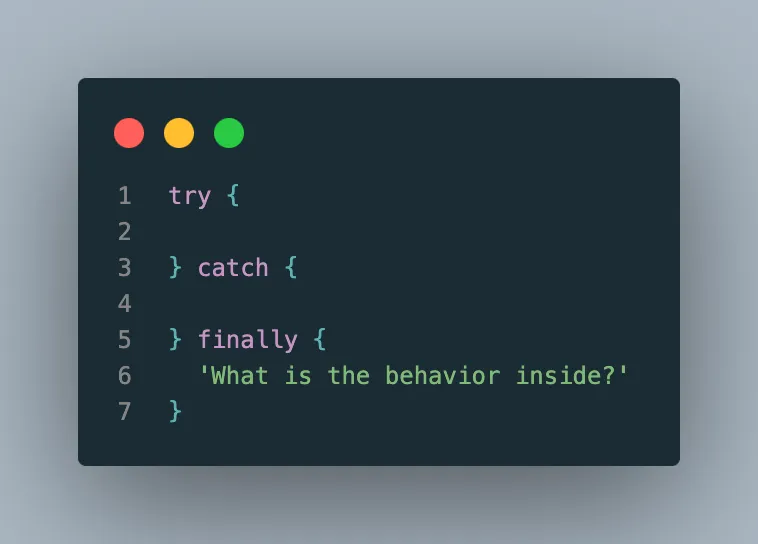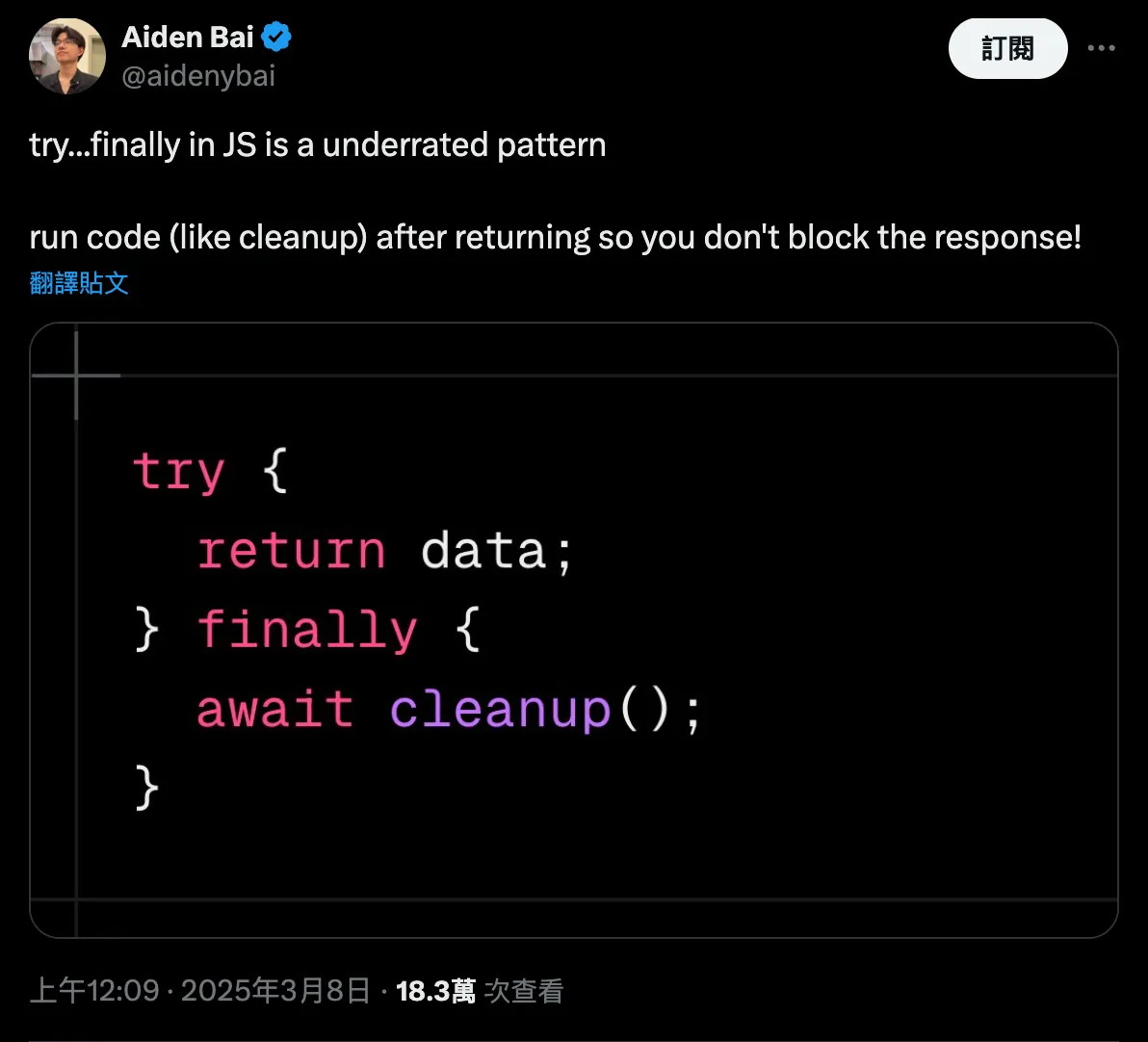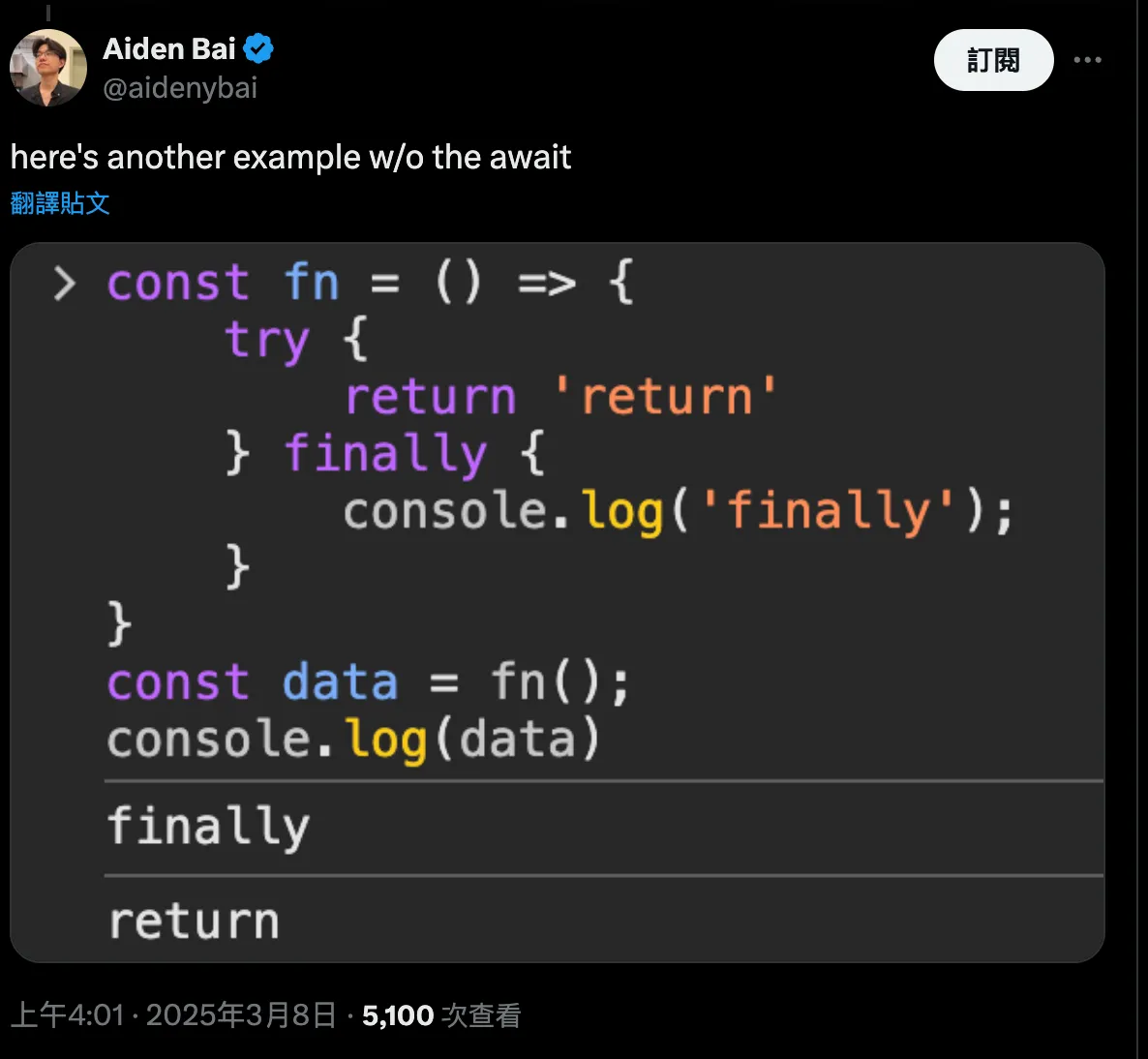
The `finally` behavior in `try…catch` of JavaScript
finally behavior in JavaScript
· javascript · 6 minutes
來源

- https://x.com/aidenybai/status/1898043212238901444
- https://developer.mozilla.org/en-US/docs/Web/JavaScript/Reference/Statements/try…catch#the_finally_block
原文是希望藉由這樣的寫法,不 block 到 response(return data)的情況下,在 finally block 做最後的 cleanup,但是適得其反,為什麼呢?
 他自己也注意到了,
他自己也注意到了,finally block 會先執行,才回 return try block 的值,怎麼會這樣?
來看看文件怎麼寫
根據 MDN 的 The finally block 段落,寫道 finally block 執行的時機點有 3 個:
- Immediately after the
tryblock finishes execution normally (and no exceptions were thrown);- Immediately after the
catchblock finishes execution normally;- Immediately before the execution of a control-flow statement (
return,throw,break,continue) in thetryblock orcatchblock that would exit the block.
前面兩點相信很好懂,重點在第三點:「finally 會在執行任何 control-flow statement 之前就會馬上執行,包括在 try block 和 catch block 當中,可能會導致離開 block 的 control-flow statement」
What is control-flow statement?
根據上面原文來舉例,就會是 try block 裡面的 return ,因此 finally block 的 await cleanup() 會先執行,才執行 try block 的 return
舉個例子:
const fn = () => { try { console.log("try"); return "true"; } finally { console.log("finally"); }};
const data = fn();console.log("data: ", data);print log 的順序會是:
tryfinallytrue可以看到 try block 的return 最後才被執行
如果把上面例子的 return “true” 改成 throw “123”:
const fn = () => { try { console.log("try"); throw "123"; } finally { console.log("finally"); }};
const data = fn();console.log("data: ", data);print log 的順序會是:
tryfinallyError: 123結果差不多,可以看到 throw 錯誤之前,finally block 會先被執行
回到原文中的例子:
const cleanup = () => new Promise((resolve) => { console.log("resolve"); resolve(); });
const fn = async () => { try { console.log("try"); return "true"; } finally { console.log("finally"); await cleanup(); }};
fn().then((data) => { console.log("data: ", data);});print 出 log 的順序則是:
tryfinallyresolvedata: true很明顯可以看到 finally block 的 promise 執行完之後,才執行 return “true”
可以用什麼替代原文作者的寫法?
只在 finally block 寫 control-flow statement(not perfect)
const fn = async () => { try { console.log("try"); } finally { cleanup(); return "true" }};有網友提供這樣的寫法,可以在 cleanup 後接著 return value,一石二鳥。不過如果今天 try block 裡面需要 await data 或做其它事,必須還得在外面 assign 一個變數,才能讓 finally block return data 出去,像這樣:
const fn = async () => { let data; try { console.log("try"); data = await doSomething(); } finally { cleanup(); return data; }};另外就是,假如希望 catch block 能 throw error 或 return error 到外面去,讓外部知道有 error,這種寫法可能就不適合了。
老老實實地在 try…catch 執行完的下一行做 cleanup
const cleanup = () => new Promise((resolve) => { console.log("resolve"); resolve(); });
const fn = () => { try { console.log("try"); return "true"; } catch (error) { console.log("error: ", error); }};
fn();cleaup();夠粗暴,且簡單與直覺。
用 .finally()
const cleanup = () => new Promise((resolve) => { console.log("resolve"); resolve(); });
const fn = async () => { try { console.log("try"); return "true"; } catch (error) { console.log("error: ", error); }};
fn() .then((data) => { console.log("data: ", data); }) .finally(() => { console.log("finally"); cleanup(); });可以用 .finally() 的方式來做取代,這種方式基本上可以確保 return 值之後,才會進到 .finally(),缺點就是寫起來會變得又臭又長?
要寫得比較完整的話,可以再加上 .catch()
const cleanup = () => new Promise((resolve) => { console.log("resolve"); resolve(); });
const fn = async () => { try { console.log("try"); return "true"; } catch (error) { throw error; }};
fn() .then((data) => { console.log("data: ", data); }) .catch((error) => { console.log("error: ", error); }) .finally(() => { console.log("finally"); cleanup(); });另一個比較常見的寫法:用 Promise 包著
const cleanup = () => new Promise((resolve) => { console.log("resolve"); resolve(); });
const fn = () => { return new Promise((resolve, reject) => { try { console.log("try"); resolve("true"); } catch (error) { reject(error); } });};
fn() .then((data) => { console.log("data: ", data); }) .catch((error) => { console.log("error: ", error); }) .finally(() => { console.log("finally"); cleanup(); });千萬別這麼做
看到原文串有人舉一個例子表示千萬別這麼做,否則會討厭你自己
function tryMe() { console.log("1. start!"); try { return "2. return from try"; } catch (error) { return "3. return from catch"; } finally { return "4. return from finally"; }}
console.log(tryMe());log 的順序將會是:
1. start!2. return from finally沒錯,直接略過 try 跟 catch block
即使你今天在 try block 丟出一個錯誤,也不會 return catch block 的字串
總結
finally block 目前看起來存在著些違反直覺的機制,可能會在無意中寫出令你驚喜的情況,看起來能不用就不用,似乎也沒有非得使用的必要。若仍要使用,請絕對要小心服用,並有意識地在知道 finally block 的機制下去做使用。
網友分享另一個變形題
const xit = async () => { const zit = () => { console.log("second"); return "fourth"; };
try { await new Promise((resolve) => setTimeout(resolve), 100); console.log("first"); return zit(); } finally { console.log("third"); }};
(async () => { const data = await xit(); console.log("data: ", data);})();猜猜答案會是什麼?
